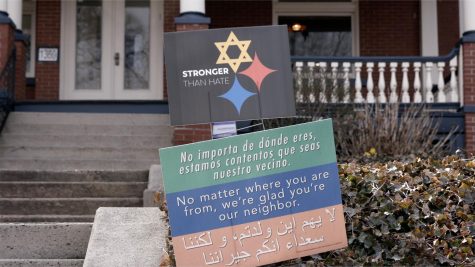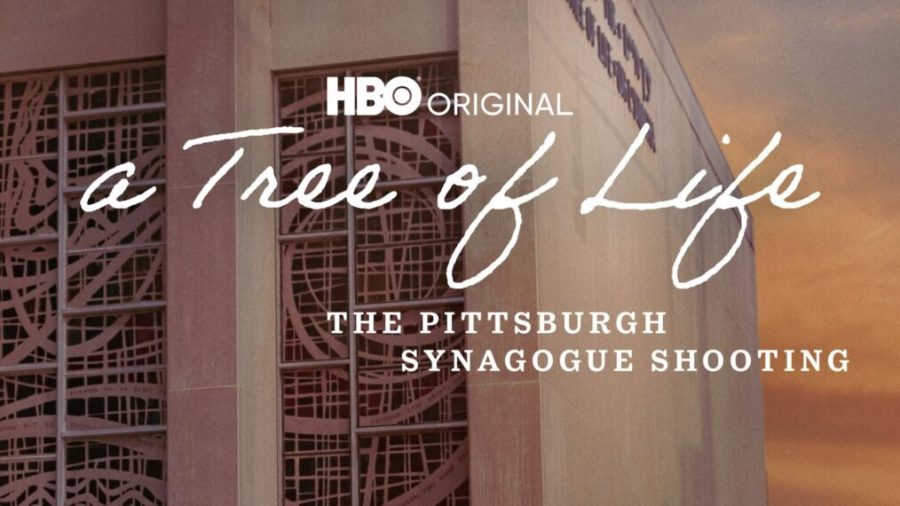What you need to know before watching the “Tree of Life” HBO documentary
Published October 19, 2022
Filmmaker Trish Adlesic’s “A Tree of Life: The Pittsburgh Synagogue Shooting” is a deeply personal portrait of those who survived the horror of the Oct. 27, 2018, massacre.
Told through first-person accounts, the film documents the violence and terror that unfolded that day —but it is also a story of survival and strength seen through the eyes of survivors, family members of those who were killed and the community.
This style of storytelling was important to the director. Adlesic said that she knew it was the firsthand accounts that mattered.
“In my heart, I knew that the only people who could tell this story were the ones who lived through it, and those who were left behind to endure the never-ending pain of losing their loved ones to such an unfathomable antisemitic tragedy,” she said.

“A Tree of Life” opens with survivor Audrey Glickman blowing the shofar from a rooftop across the street from the building that housed the three congregations targeted during the shooting —Congregation Dor Hadash, New Light Congregation and Tree of Life*Or L’Simcha Congregation. That peaceful image is intercut with footage from outside the building during the attack. Audio heard on police radios helps convey the confusion and fear that morning and is interspersed with running commentary from many of the survivors and their relatives.
Firsthand accounts by Audrey Glickman, Anthony Fienberg, Michele and Diane Rosenthal, Carol Black, Barry Werber, Joe Charny, Andrea Wedner, Stephen Weiss and Dan Leger, as well as contemporaneous footage and radio clips paint the most complete picture of what took place inside the synagogue.
“As I got into the doorway, there were a series of probably four or five shots, and as I’m standing in the doorway, I can see shell casings bouncing across the floor in front of me,” survivor Stephen Weiss remembers approximately four minutes into the film.
That harrowing dialogue is followed by survivor Dan Leger, a nurse, discussing how he and fellow congregant, friend and doctor Jerry Rabinowitz, heard the gunshots and did the unthinkable: They moved toward the sound of gunfire to see if they could help. They were both shot. Leger was seriously wounded and Rabinowitz was killed.
The film doesn’t only retell the story of the terror of Oct. 27. Adlesic allows space for Werber, Rabbi Jonathan Perlman of New Light and Glickman to recount memories from their youth, telling the tale of a mostly peaceful Pittsburgh that integrated the Squirrel Hill Jewish community as one of its immigrant neighborhoods.
The portrait painted in “A Tree of Life” is one of a Jewish neighborhood that could have been placed in any city in the United States. We learn the mundane reasons survivors decided to attend synagogue services that rainy Shabbat morning — Carol Black talks of deciding to attend shul instead of taking her weekly walk due to an injury. Her brother, Richard Gottfried, was killed in the massacre. Barry Werber, who typically attended services on Friday and Sunday, went to the synagogue that Saturday morning to mark the yahrzeit of his mother.
The quiet of a routine Shabbat is shattered by the gunman. The sometimes-tortured memories of survivors move the documentary back inside the building in the moments immediately following the attack.
Black recounts hearing the “bam, bam, bam, bam, bam, bam” of rapid gunfire. Tree of Life custodian Augie Siriano, who has worked at the synagogue since 1993, said he “heard shots, saw magazines and smelled gunpowder” before running out the door.
Glickman remembers not having her cellphone with her after fleeing the synagogue because her pockets were too shallow to hold it.
Leger tells of being shot, believing he would die, and the calm he found in memories of his life and his Jewish faith.
In one particularly chilling episode, Werber recounts being in a dark room when the shooter entered, stepping over the body of Melvin Wax, whom he had shot.
“I could see the long gun,” Werber said. “I knew the type. It was some sort of automatic weapon.”
Following these firsthand accounts, viewers learn that the shooter targeted the building because of Dor Hadash’s participation in HIAS’ (Hebrew Immigrant Aid Society) National Refugee Shabbat. And the documentary posits a direct correlation between the massacre and the anti-immigration rhetoric by Donald Trump and right-wing commentators like Tucker Carlson.
It also confronts the culture of gun ownership and white supremacist groups in America. Brad Orsini, former Jewish Federation of Greater Pittsburgh Community Security Director and a former FBI agent, is shown teaching security training in the city. White supremacist groups, he says, are emboldened and feel empowered, he says, then adds: “I think too many people have guns that shouldn’t.”
Other controversies discussed in the film include former President Trump’s visit to the city following the shooting and the possibility of the death penalty for the shooter.
“Executing him is too easy,” Black says. “I don’t want him to have it easy.”
“I always thought I was against the death penalty,” says Anthony Fienberg, whose mother, Joyce Fienberg, was murdered during the attack. “I’m a supporter of the death penalty in this case. Will that change anything? Probably not, except sending a message to those thinking of perpetrating this type of crime.”
Adlesic said it was important to confront these issues.
“In the film, the viewer is asked to consider the complex issues that drive antisemitism, racist hate rhetoric and hate crimes, gun control, a perspective on intersectional justice that considers everyone affected by white supremacy, and, ultimately, healing through the voices, thoughts and experiences of the survivors and the families of the slain,” she said. “There are no ‘talking heads’ in this production, just the first-person exchange essential to create a connection with the audience and motivate change around some of the most difficult issues our society faces today: the exponential rise of antisemitism, white supremacy and racist hate.”
And while it would be easy to simply focus on the terror of the shooting and the memories of the survivors and the victims’ families, “A Tree of Life” also tells the story of the bravery of first responders and the strength and kindness of the community.
The documentary ends by highlighting the names of the 11 victims of the massacre: Joyce Fienberg, Richard Gottfried, Rose Mallinger, Jerry Rabinowitz, Cecil and David Rosenthal, Bernice and Sylvian Simon, Daniel Stein, Melvin Wax and Irving Younger.
The decision to end the film that way was part of the process Adlesic used when creating the documentary.
“The Hebrew phrase ‘zikhrono livrakha’ (may their memory be a blessing) has entered mainstream American conversation, shared among non-Jews as well as Jews, but in practice what does ‘may their memory be a blessing’ mean? What does it mean in the face of unspeakable loss? What does it mean when it is practiced by an entire community and city? Is it a condolence, a remembrance, a guide for a better future? ‘A Tree of Life’ was made with the sacred memory of the victims and the lives of the survivors at the center of every production and artistic decision,” she said.
Written and directed by Adlesic and executive produced by Pittsburgh natives Michael Keaton, Billy Porter and Mark Cuban, “A Tree of Life” premieres on HBO and HBO Max at 9 p.m. on Oct. 26.















